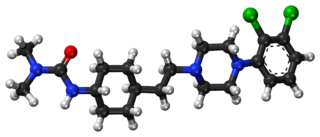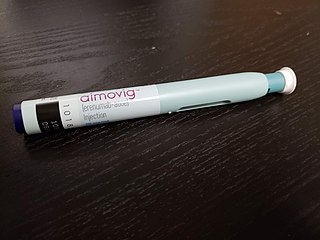
Migraine is a genetically influenced complex neurological disorder characterized by episodes of moderate-to-severe headache, most often unilateral and generally associated with nausea and light and sound sensitivity. Other characterizing symptoms may include nausea, vomiting, cognitive dysfunction, allodynia, and dizziness. Exacerbation of headache symptoms during physical activity is another distinguishing feature. Up to one-third of migraine sufferers experience aura, a premonitory period of sensory disturbance widely accepted to be caused by cortical spreading depression at the onset of a migraine attack. Although primarily considered to be a headache disorder, migraine is highly heterogenous in its clinical presentation and is better thought of as a spectrum disease rather than a distinct clinical entity. Disease burden can range from episodic discrete attacks, consisting of as little as several lifetime attacks, to chronic disease.

Candesartan is an angiotensin receptor blocker used mainly for the treatment of high blood pressure and congestive heart failure. Candesartan has a very low maintenance dose. Like Olmesartan, the metabolism of the drug is unusual as it is a cascading prodrug. Candesartan has good bioavailibility and is the most potent by weight of the AT-1 receptor antagonists.

Calcitonin gene-related peptide (CGRP) is a member of the calcitonin family of peptides consisting of calcitonin, amylin, adrenomedullin, adrenomedullin 2 (intermedin) and calcitonin‑receptor‑stimulating peptide. Calcitonin is mainly produced by thyroid C cells whilst CGRP is secreted and stored in the nervous system. This peptide, in humans, exists in two forms: CGRP alpha, and CGRP beta. α-CGRP is a 37-amino acid neuropeptide and is formed by alternative splicing of the calcitonin/CGRP gene located on chromosome 11. β-CGRP is less studied. In humans, β-CGRP differs from α-CGRP by three amino acids and is encoded in a separate, nearby gene. The CGRP family includes calcitonin (CT), adrenomedullin (AM), and amylin (AMY).

Antimigraine drugs are medications intended to reduce the effects or intensity of migraine headache. They include drugs for the treatment of acute migraine symptoms as well as drugs for the prevention of migraine attacks.

Prucalopride, sold under brand names Resolor and Motegrity among others, is a medication acting as a selective, high affinity 5-HT4 receptor agonist which targets the impaired motility associated with chronic constipation, thus normalizing bowel movements. Prucalopride was approved for medical use in the European Union in 2009, in Canada in 2011, in Israel in 2014, and in the United States in December 2018. The drug has also been tested for the treatment of chronic intestinal pseudo-obstruction.

Telcagepant (INN) is a calcitonin gene-related peptide receptor antagonist which was an investigational drug for the acute treatment and prevention of migraine, developed by Merck & Co.

Cariprazine, sold under the brand names Vraylar, Reagila and Symvenu among others, is an atypical antipsychotic developed by Gedeon Richter, which is used in the treatment of schizophrenia, bipolar mania, bipolar depression, and major depressive disorder. It acts primarily as a D3 and D2 receptor partial agonist, with a preference for the D3 receptor. Cariprazine is also a partial agonist at the serotonin 5-HT1A receptor and acts as an antagonist at 5-HT2B and 5-HT2A receptors, with high selectivity for the D3 receptor. It is taken by mouth.
Calcitonin gene-related peptide (CGRP) receptor antagonists are a class of drugs that act as antagonists of the calcitonin gene-related peptide receptor (CGRPR).

Lemborexant, sold under the brand name Dayvigo, is an orexin antagonist medication which is used in the treatment of insomnia. It is indicated specifically for the treatment of insomnia characterized by difficulties with sleep onset and/or maintenance in adults. The medication is taken by mouth.

Relamorelin is a synthetic peptide, centrally penetrant, selective agonist of the ghrelin/growth hormone secretagogue receptor (GHSR) which is under development by Allergan pharmaceuticals for the treatment of diabetic gastroparesis, chronic idiopathic constipation, and anorexia nervosa. It is a pentapeptide and an analogue of ghrelin with improved potency and pharmacokinetics. In humans, relamorelin produces increases in plasma growth hormone, prolactin, and cortisol levels, and, like other GHSR agonists, increases appetite. As of June 2015, relamorelin is in phase II clinical trials for diabetic gastroparesis and constipation. The United States Food and Drug Administration (FDA) has granted Fast Track designation to relamorelin for diabetic gastroparesis. The development of the drug is uncertain as the most recent mention of it was in a 2019 SEC filing from the drug manufacturer lists the drug's expected launch year as 2024, but not in subsequent filings or press releases.

Finerenone, sold under the brand name Kerendia and Firialta, is a medication used to reduce the risk of kidney function decline, kidney failure, cardiovascular death, non-fatal heart attacks, and hospitalization for heart failure in adults with chronic kidney disease associated with type 2 diabetes. Finerenone is a non-steroidal mineralocorticoid receptor antagonist (MRA). It is taken orally.
Eptinezumab, sold under the brand name Vyepti, is a medication used for the preventive treatment of migraine in adults. It is a monoclonal antibody that targets calcitonin gene-related peptides (CGRP) alpha and beta. It is administered by intravenous infusion every 3 months.

Galcanezumab, sold under the brand name Emgality, is a humanized monoclonal antibody used for the prevention of migraine. It is also used for cluster headaches.

Erenumab, sold under the brand name Aimovig, is a medication which blocks the calcitonin gene-related peptide receptor (CGRPR) for the prevention of migraine. It is administered by subcutaneous injection.

Rimegepant, sold under the brand name Nurtec ODT among others, is a medication used for the acute treatment of migraine with or without aura in adults and the prophylactic/ preventive treatment of episodic migraine in adults. It is taken by mouth to dissolve on or under the tongue. It works by blocking CGRP receptors.

Upadacitinib, sold under the brand name Rinvoq, is a medication used for the treatment of rheumatoid arthritis, psoriatic arthritis, atopic dermatitis, ulcerative colitis, Crohn's disease, ankylosing spondylitis, and axial spondyloarthritis. Upadacitinib is a Janus kinase (JAK) inhibitor that works by blocking the action of enzymes called Janus kinases. These enzymes are involved in setting up processes that lead to inflammation, and blocking their effect brings inflammation in the joints under control.
Fremanezumab, sold under the brand name Ajovy, is a medication used to prevent migraines in adults. It is given by injection under the skin.

Ubrogepant, sold under the brand name Ubrelvy, is a medication used for the acute (immediate) treatment of migraine with or without aura in adults. It is not indicated for the preventive treatment of migraine. Ubrogepant is a small-molecule calcitonin gene-related peptide receptor antagonist. It is the first drug in this class approved for the acute treatment of migraine.
Peter GoadsbyFRS FRACP FRCP is an Australian neuroscientist who is Director of the National Institute for Health Research - Wellcome Trust King’s Clinical Research Facility and Professor of Neurology at King's College London. His research has focused particularly on the mechanism and alleviation of migraine and cluster headaches.

Zavegepant, sold under the brand name Zavzpret, is a medication used for the treatment of migraine. Zavegepant is a calcitonin gene-related peptide receptor antagonist. It is sprayed into the nose. It is sold by Pfizer.
















